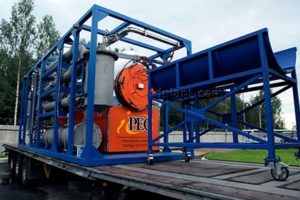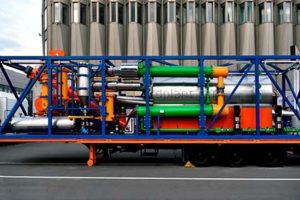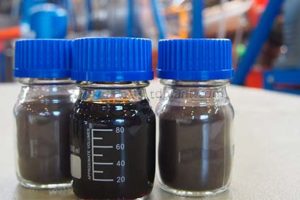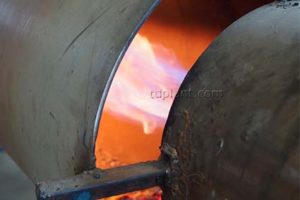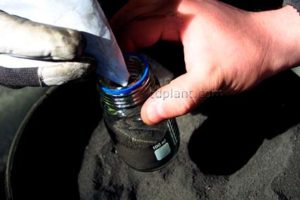Pyrolysis is the process of thermal decomposition of organic substances in an oxygen-deficient environment to hydrocarbons with a lower molecular weight. Carbon-to-carbon bonds are broken under the influence of high temperatures. The yield and qualitative composition of pyrolysis products depend on the properties of the feedstock and the temperature mode of the process.
Interesting fact about pyrolysis: historically, the first pyrolysis equipment appeared in the XII century in Russia. The process of tar distillation (that was the name of pine wood pyrolysis back then) produced pine resin, which was used to protect wooden ships and ropes from moisture by tarring and impregnation. In the 16th century, this process reached an industrial level in Sweden, where in addition to extracting wood resins, charcoal was produced for the metallurgical industry. The process was classified in order to monopolize the resin market. All the maritime powers bought impregnating materials from Sweden, replenishing its treasury.
Historical reference: In 1877 Russian chemist A.A. Letnyi patented the technology of HC pyrolysis with obtaining lighting gas. It was during this period that the fundamental principles of oil pyrolysis process were discovered. The ability of heavy oil residues to disintegrate into lighter fractions (gasoline, kerosene, lighting gas) was discovered, and aromatic hydrocarbons — benzene derivatives — were extracted for the first time. Thus, historically, pyrolysis became the engine for development of the chemical, petrochemical, and energy industries.
When did pyrolysis technology was adopted for waste recycling?
The adaptation of pyrolysis technology for waste recycling began in the 50s of the twentieth century. This method became widespread in Japan, European countries and North America. The target product of waste recycling was liquid pyrolysis fuel. In Russia today there are pyrolysis technologies that allow to obtain marketable products, suitable for the intended use without further processing.
Waste is a raw material for obtaining marketable pyrolysis products
The annual increase in waste generation requires the most efficient, safe and cost-effective ways of its disposal. The thermal decomposition process allows obtaining valuable products from waste. It is versatile and makes it possible to recycle and dispose of organic waste of any complexity, such as:
- waste tires and rubber waste
- plastics
- acid tar
- oil-contaminated soil
- oil-contaminated waste (drill cuttings, drilling scrap, oily soil and substrate)
- waste oils
- electronic and automotive scrap
- sludge from wastewater treatment plants.
Products of thermal decomposition of waste are valuable marketable goods
The continuous pyrolysis process produces boiler fuel, carbon black or technical soil (depending on the processed raw material), and pyrolysis gas. Secondary hydrocarbon raw materials and fuels are in high demand due to the increasing urgency of environmental management. And there is no doubt that this demand will only grow every year. «Pyrolysis oil is a real way for the petrochemical industry to reduce the consumption of fossil oil», (Linda Sandström, Project Manager at “Enviro Systems AB” (Sweden).
Interesting fact about pyrolysis: according to archaeological research, Neanderthals produced charcoal and medicinal tar by pyrolysis back in the Middle Paleolithic era. They filled the trenches with wood, covered them with turf and above with earth. After that they ignited the wood on the windy side and after its reaching full flame limited the access of air as much as possible. The charcoal was used as a source of heat for heating homes, cooking, and for improving soil fertility. In this way, thermal decomposition technology gave an impetus to the development of civilized society.
Pyrolysis gas is a product of thermal decomposition, which is not inferior in some ways to natural gas
The gaseous product of pyrolysis can serve as an alternative fuel since it has sufficient calorific value to support some industrial processes and space heating.
Historical background of the pyrolysis gas: In 1901, English inventor Thomas Hugh Parker invented the first car powered by pyrolysis gas. Up until 1930, pyrolysis gas was called «lighting gas» because it was used for street lamps. Subsequently, it was replaced by natural gas.
Electricity generation – an optional feature for thermal decomposition technology
Pyrolysis gas can be forwarded to a gas-turbine unit, which will also produce electric power from waste. Such a solution is already implemented in the technological complex of the continuous pyrolysis unit of the TDP-2 type with a power generating system (Capstone gas-turbine unit). The amount of electricity generated depends on the calorific value, type and volume of the processed raw materials. This feature is widely used in the world.
«The feasibility of power generation using pyrolysis technology in regions where shortages in power are present is attractive», (Nicholas Leath, CEO of “Altona Energy PLC”, an Australian mining and exploration company).
Heat production – an optional feature of thermal decomposition technology
By equipping thermal destruction plants with optional heat exchange equipment it is possible to generate up to 1.5 MW of thermal energy per hour. The thermal energy can be used for various process and utility purposes.
Today pyrolysis is the most environmentally sound technology in the field of organic waste recycling
Unlike incineration, thermal decomposition of raw materials in an oxygen-free environment is not accompanied by the formation of poisonous sulfur and nitrogen oxides, carcinogenic and polluting substances, which prevents the negative impact on the environment. This is an indisputable advantage compared also to the natural decomposition process (landfilling) as well as to the waste incineration method, which requires expensive gas purification system.
Pyrolysis Technology Reduces Greenhouse Gas Emissions by 14%
According to a study by the U.S. Department of Energy’s Argonne National Laboratory, for example, fuel-derived plastic pyrolysis technology reduces greenhouse gas emissions by up to 14%, energy consumption can be reduced by 96%, and water consumption by 58% (Analysis of the report).
Pyrolytic processes development does not stop
Modern science and industry are actively researching the possible expansion of the use of pyrolytic processes. For example, the U.S. news agency “Science Daily”, LLC reports that engineers at Rice University (USA) suggest using pyrolysis to restore oil-soaked soil to fertility while removing toxic hydrocarbons (Read more in «Pilot-Scale Pyrolytic Remediation of Crude-Oil-Contaminated Soil in a Continuously-Fed Reactor: Treatment Intensity Trade-Offs»).
Landfilling of waste containing useful components is prohibited
According to Russian Government Order No. 1589-r of July 25, 2017, the disposal of production and consumption waste containing useful components is prohibited. It is the thermal decomposition method that allows such waste to be effectively recycled. Beginning January 1, 2019, polymeric materials (films, containers, etc.) and used tires are banned from disposal. From January 1, 2021, it is prohibited to landfill electronic and electrical scrap. All these are valuable raw materials for thermal destruction, and recycling will cost considerably less than dumping them in landfills.
Cutting edge unique thermal decomposition technology is used in TDP-type units
- The technology and processes of thermal decomposition were practically unchanged, only pyrolysis equipment was changed. The improvement of the apparatus and the evolution of technical solutions led to the achievement of high energy and environmental performance.
- Cutting edge unique thermal decomposition technology is used in TDP-type units. Thermal decomposition unit of TDP-type is widely used in Russia and abroad due to its high efficiency, continuous production cycle, compact size due to its modular design, full compliance with international quality and safety requirements.
